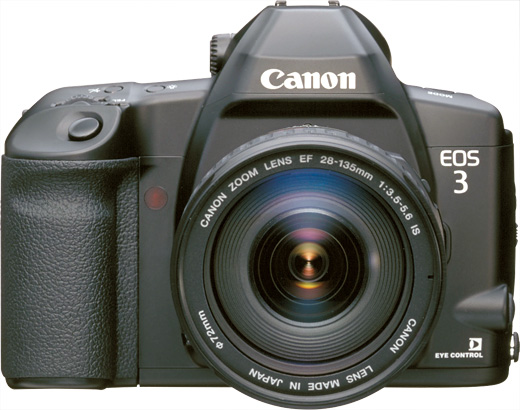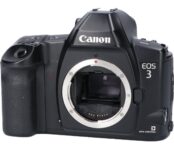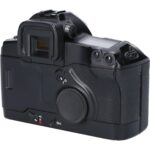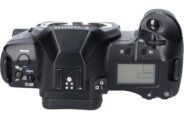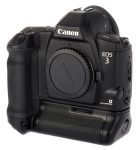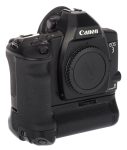Announced
Production status
System
Canon EOS system cameras
- Canon EF-M
- Canon EOS 10 S
- Canon EOS 10D
- Canon EOS 1D
- Canon EOS 1D mark II
- Canon EOS 1D mark II N
- Canon EOS 1D mark III
- Canon EOS 1D mark IV
- Canon EOS 1D X
- Canon EOS 1D X Mark II
- Canon EOS 1D X Mark III
- Canon EOS 1Ds
- Canon EOS 1Ds mark II
- Canon EOS 1Ds mark III
- Canon EOS 3
- Canon EOS 3000
- Canon EOS 5000
- Canon EOS 5D
- Canon EOS 5D mark II
- Canon EOS 5D mark III
- Canon EOS 5D mark IV
- Canon EOS 5Ds
- Canon EOS 5Ds R
- Canon EOS 620
- Canon EOS 630
- Canon EOS 650
- Canon EOS 6D
- Canon EOS 6D Mark II
- Canon EOS 700
- Canon EOS 750 QD
- Canon EOS 850
- Canon EOS A2
- Canon EOS D30
- Canon EOS D60
- Canon EOS ELAN
- Canon EOS ELAN 7E
- Canon EOS ELAN 7NE
- Canon EOS ELAN II
- Canon EOS IX
- Canon EOS IX Lite
- Canon EOS Rebel 2000
- Canon EOS Rebel G
- Canon EOS Rebel K2
- Canon EOS Rebel S II QD
- Canon EOS Rebel T2
- Canon EOS Rebel Ti
- Canon EOS Rebel X
- Canon EOS Rebel XS
- Canon EOS Rebel XS N DATE
- Canon EOS RT
- Canon EOS-1
- Canon EOS-1N
- Canon EOS-1N RS
- Canon EOS-1V
Canon EOS 3
35mm AF film SLR camera • Discontinued
Specification
| Format: | |
| 35mm full frame | |
Film type: | 135 cartridge-loaded film |
| Canon EF [44mm] | |
| Shutter: | |
Type: | Focal-plane |
Model: | Electronically controlled |
Speeds: | 30 - 1/8000 + B |
| Exposure: | |
Exposure metering: | Through-the-lens (TTL), open-aperture |
Exposure modes: | Programmed Auto |
| Aperture-priority Auto | |
| Shutter-priority Auto | |
| Manual | |
| Physical characteristics: | |
Weight: | 780g |
Dimensions: | 161x119.2x70.8mm |
Manufacturer description #1
September 10, 1998
Canon Expands Camera Technology with EOS 3
Ten years after launching the world's most successful range of SLR cameras, Canon has advanced camera technology a step further with the launch of the EOS 3 - a camera that further improves the speed and performance for which the EOS range is renowned.
The EOS 3 incorporates the world's first area AF system, a high precision focusing system, faster eye-control and improved high-speed focus tracking. Such technology combined with many of the features of the EOS 1N and, of course compatibility with the extensive range of over 50 EF lenses and accessories, make the EOS 3 the perfect choice for advanced amateurs and professionals alike.
The EOS 3 design is based on that of the EOS 1N - sturdy with easily accessible controls for quick and easy execution of camera operations.
A range of accessories developed specifically for the EOS 3, including a new Speedlite flash, will be launched at the same time (separate release available).
World's First Wide Area AF
The world's first area AF measuring 8mm x 15mm - 23% of the EOS 3 viewfinder - which uses 45 focusing points for more accurate subject capture. This is done using a new Canon-developed CMOS area sensor and a new AF optical system. Of the 45 focusing points, seven at the centre are high precision cross type sensors for f/2.8 lenses (or faster), while the other 38 are sensitive to horizontal lines at f/5.6. The result is greatly enhanced prospects of capturing the desired subject.
Even with an f/4 or faster lens the centre focusing point works as a cross-type focusing sensor, enabling AF shooting with EF300mm f4L USM and 2x extender. Any one of the 45 focusing points can be selected using a button-and-dial operation with the selected point superimposed in red in the viewfinder for easy recognition.
Faster AF
Outstanding high speed focus tracking is achieved using a 32 bit microcomputer and high speed predictive algorithm. Seven frames per second (fps) shooting with predictive AF and AI Servo AF is possible with the new Power Drive Booster (PB-E2) and a nickel metal hydride rechargeable battery pack, the NP-E2.
Using the built-in motor drive, 4.3 fps can be achieved with the same low noise level as the EOS 1N.
Eye Control
The same 32 bit microcomputer used to improve the high speed focus also gives faster and more precise eye-control operation - about twice the speed previously possible, alongside improved accuracy.
By combining the area AF and eye-control, focus is achieved at the point selected by the user's eye. An eye control indicator and high-speed sync indicator have been added to the bottom of the viewfinder display.
Metering System
The EOS 3 incorporates seven metering methods compatible with the area AF system: 21-zone evaluative metering linked to the focusing points, partial metering at the centre (8.5% of viewfinder screen), spot metering at centre (2.4% of viewfinder screen), spot metering linked to the focusing point, centre weighted and average metering, preflash metering and off-the-film TTL. Multispot metering is possible for up to 8 points.
A newly developed rotary magnet-controlled ultra-fast shutter electronically regulates shutter speeds for maximum accuracy. Shutter speed range is 30sec to 1/8000sec, maximum sync speed is 1/200sec and shutter durability an estimated 100,000 cycles.
However, the flash can be synced up to 1/8000 of a second, using the FP flash mode on the new 550EX and 380EX Speedlites.
An LCD panel on the top of the camera displays the camera settings at a glance, including, for the first time on an EOS, a remaining-frame counter. For low light conditions a built-in illumination system enhances the display.
Basic operation is very similar to the EOS 1N - most operations can be performed without taking your eye off the viewfinder or your finger off the shutter button. The same camera control layout presents no familiarity problems for EOS 1N users, while up to 18 custom functions can be preset for enhanced flexibility.
New accessories
To complement the EOS 3, a range of new accessories have been launched.
The new Speedlite 550EX incorporates an AF-assist beam that is linked to the area AF, as well as FEB, an E-TTL wireless multiflash control system and slave unit control. Flash coverage is set automatically from 24mm to 105mm, and a wide-angle panel extends the coverage to 17mm.
For E-TTL wireless (multi-flash) autoflash shots, the ST-E2 Speedlite Transmitter mounted on the camera's hot shoe controls the Speedlite 550EX. The transmitter also has a built-in AF assist beam linked to the area AF.
A new Power Drive Booster PB-E2, which can also be attached to the EOS-1 and EOS 1N, has its own shutter button, AE lock button, FE lock/multi-spot metering button, Mail Dial, focusing point selector and ON/OFF switch for the Power Drive Booster buttons.
A 12V 1350mAh nickel metal hydride Battery Pack, NP-E2, is dedicated for use with the EOS 3 and PB-E2 Power Drive Booster and can be used to increase maximum continuos shooting speed to 7 fps. The new NC-E2 charger/discharger dedicated to the NP-E2 battery pack will charge the battery pack in about 100 minutes.
Other new accessories are the DB-E2 Dateback, a standard interchangeable camera back with Quick Control Dial and date imprinting function; the Timer Remote Controller TC-80N3, with four built-in control functions: self-timer, interval timer, long-exposure timer and frame quantity setting.
Also launched are a Remote Switch RS-80N3, the Extension Cord ET-1000N3, Wireless Controller LC-4 and the Remote Switch Adapter RA-N3.
The EOS 3 will be available from November 1998 at a RRP of £999.99.
Manufacturer description #2
To continue the EOS story, Canon introduces the EOS 3. This camera further improves speed and performance for which the EOS range is renowned. The EOS 3's AF system, uses 45 focusing points for more accurate subject capture. This feature when combined with a high precision focusing system, faster eye control and improved high speed focus as well as compatibility with over 50 EF lenses and accessories means that the EOS3 is the ultimate camera for advanced amatuers and professionals alike.
World's First Wide Area Auto Focus
Using a new Canon developed CMOS area sensor combined with a new AF optical focus system the EOS 3 has a wide area Auto Focus area of 8mm x 15mm containing 45 focusing points for more accurate subject capture. Of the 45 focusing points, seven at the centre are high precision cross type sensors for f2.8 lenses (or faster), while the other 38 are sensitive to horizontal lines at f/5.6. The result is greatly enhanced prospects of capturing the desired subject.
Even with an f/4 or faster lens the centre focusing point works as a cross type focusing sensor, enabling AF shooting with EF300mm f2.8L USM and 1.4x extender. Any one of the 45 focusing points can be easy selected using a button and dial operation with the selected point superimposed in red in the viewfinder for easy recognition.
Faster Auto Focus
High speed focus tracking is achieved using a 32 bit microcomputer and high speed predictive algorithum. The Power Drive Booster (PB-E2) makes it possible for shhoting at seven frame per second with both predictive AF and Al Servo AF. The EOS 3 built in motor drive allows shooting at up to 4.3fps with the same low noise level as the EOS 1N.
Eye Control
A combination of the area AF and eye control allows focus to be achieved at the point the eye chooses. Using the 32 bit microcomputer employed for faster Auto Focus commands, the EOS 3 is able to give the user faster and more precise eye control operation through improved accuracy in pupil edge detection. The viewfinder has been further enhanced through the addition of an eye controlled indicator and high speed sync indicator allowing the user maximum control.
Metering System
The EOS 3 has seven metering methods compatible with the area AF system:
- 21 zone evaluative metering linked to the focusing points
- Partial metering at centre (8.5% of viewfinder screen)
- Spot metering at centre (2.4% of viewfinder screen)
- Spot metering linked to focusing point
- Centreweighted and average metering
- Preflash metering and off the film TTL
- Multi spot metering is possible for up to 8 points
Shutter Speed
The EOS 3 features a newly developed rotary magnet controlled ultra fast shutter which electronically regulates shutter speeds for maximum accuracy. The EOS 3 has a shutter speed range of 30sec to 1/8000 sec, maximum sync speed of 1/200 sec and shutter durability of 100,000 cycles.
Easy Operation
With similar operation to that of the EOS 1N, the EOS 3 contains an illuminated LCD panel, displaying camera settings at a glance including a remaining frame counter. Up to 18 preset functions can be preset for enhanced flexibility.
Manufacturer description #3
A high-end SLR camera for professionals and advanced amateurs. This camera has many innovative features such as 45-point Area AF, high-speed and precision Eye Controlled Focus, and 7 fps high-speed predictive AF continuous shooting mode. The EOS3 is a camera which can fully respond to the photographer’s intention. It retains many of the features and operability of EOS-1N while also incorporating various recommendations and requests submitted by EOS-1N and EOS 5 users. It also reflects a variety of recent trends and developments in the SLR industry. This model has 45-point Area AF by Canon’s originally developed CMOS sensor and new focusing optical system. This AF system offers high subject-capturing and unrestricted framing capability. Eye Controlled Focus, refined to make it almost twice as fast and more precise than before together with 45-point Area AF system bring EOS3’s high-performance AF system another step closer to the human eye. The 21-zone evaluative metering linked to the focusing points, multi-spot metering with up to eight readings per exposure and eight metering system, including E-TTL autoflash with 550Ex are applied to this camera as well. The superb operability is achieved by dual electronic dials, 18 custom functions and firm grip holding, using the same material and design as EOS-1N. The same level of protection against moisture and dust as EOS-1N and silent film rewind are also provided. The high-performance 1/8000sec. shutter unit passed Canon’s standard endurance test of 100,000 times shutter cycle. System accessories launched at the same time as the camera include Power Drive Booster PB-E2, Ni-MH Pack NP-E2, Speedlite 550EX, Remote Switches with better clip-on operability and an anti-fog eyepiece. The nine Ec- series focusing screens for EOS-1N are compatible.
